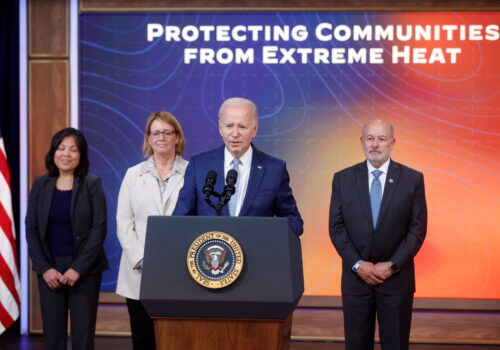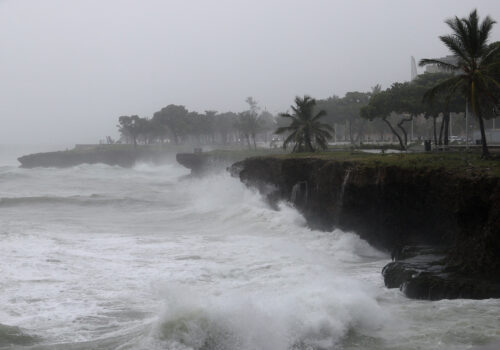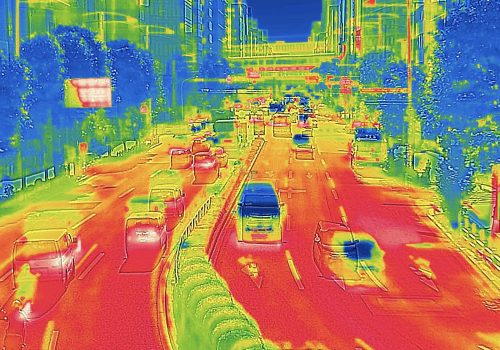The world is sleepwalking into an era of extreme heat. The UN just issued a wake-up call.
“If there is one thing that unites our divided world, it is that we are all increasingly feeling the heat,” said United Nations (UN) Secretary-General António Guterres today as he issued a Global Call to Action on Extreme Heat. The first-of-its-kind report, which I contributed to in my capacity as global chief heat officer, emphasizes the urgent need for actionable heat-related measures and policies worldwide.
In the Call to Action, the secretary-general makes clear that governments and policymakers must protect and care for the lives and livelihoods of frontline communities, protect workers, advance the evidence base to drive innovative resilience solutions, and limit global temperature rise to 1.5 degrees Celsius.
This clear recognition from the Office of the Secretary-General is an important moment for us all. Extreme heat is often underestimated and ignored, but its impacts are unavoidable. The planet is heating up faster than we thought. We are outside scientific model predictions and extreme weather events are becoming more frequent and devastating.
Rising heat affects our major critical systems—such as water, energy, food, transportation, and communications. It also feeds mega droughts, wildfires, and storms, creating cascading and compounding crises. It’s a global crisis. But we are not ready for any of it. We’re sleepwalking.
Policies to address extreme heat so far remain scattered, disjointed, and underfunded.
In my work as global chief heat officer and first chief heat officer for the city of Athens, I have worked directly with cities and have seen the impacts of heat firsthand. Cities are heating up at twice the rate of the global average. At 1.5 degrees Celsius of global warming, sixty-seven cities will experience 150 or more days per year of temperatures exceeding 35 degrees Celsius (95 degrees Fahrenheit). At 2 degrees Celsius, the number jumps to ninety-four cities. At just under 3 degrees Celsius of global warming, it soars to 197 cities.
Policies to address extreme heat so far remain scattered, disjointed, and underfunded. But the rising temperatures mark a global crisis with local impacts. That’s why the global focus of the UN’s Call to Action is so crucial. Increasingly, our world is facing challenges that go beyond the capacity and limited mandate of single nation states. We’re facing crises, like climate change, that need international cooperation to support and facilitate equitable, multilevel, science-based decision making and solutions. The UN is the only legitimate multilateral governance structure able to address issues that need global mobilization and localized solutions. As cities take on climate change, they need support at every level.
In 2022, globally, humanity spent a little over one trillion dollars on adapting to and mitigating the effects of climate change. For comparison, the world spent $11.7 trillion on COVID-19 emergency fiscal measures in 2020 alone. As temperatures rise, this funding gap is a dangerous threat. And there is another issue that needs to be urgently addressed: In 2022, about one trillion dollars went to financing emissions mitigation, while only one hundred billion dollars went to adaptation and resilience-building initiatives. We urgently need both climate adaptation and resilience financing.
The UN’s Call to Action is an important milestone for climate resilience, but it is also only the beginning. As the document explains, the world urgently needs a Global Action Strategy to “mobilize governments, policy makers, and all stakeholders to act, prevent, and reduce heat risk.” A dedicated trust fund for urban heat resilience initiatives is also needed, because cities are on the frontlines of extreme heat, and they are where more than half of the world’s population lives—a share that is expected to rise to seven-in-ten people by midcentury. Finally, more dedicated heat champions, like the community of chief heat officers established by the Arsht-Rock Resilience Center, with heat resilience departments that can articulate the challenges and co-create the best solutions are needed. These champions are critical to ensuring that the dangers of—and the solutions to—extreme heat are understood widely.
Each of these essential efforts, as well as others, requires building an international consensus around the scope of the problem and its solutions. Here, the UN’s Call to Action on Extreme Heat can help shape conversations in positive directions at upcoming conferences such as Climate Week NYC and this year’s UN Climate Change Conference of the Parties, also known as COP29. Heat resilience must be at the top of the agenda at these and other international meetings, and work is needed at every level to ensure that cities have the support and finances they need to scale solutions.
As the Call to Action makes clear, everyone is at risk from extreme heat, and we must enable resilience at the local and international level, taking “bold decisions to change the way we live to avoid an even more scorched Earth in the future.”
Eleni Myrivili is the world’s first global chief heat officer, a role jointly created and appointed by the Atlantic Council’s Arsht-Rock Resilience Center and the United Nations Human Settlements Programme (UN-Habitat).
Further reading
Wed, Jul 3, 2024
Feeling the heat? Biden’s proposed protections for workers are a welcome start.
New Atlanticist By Catherine Wallace, Owen Gow
The federal proposals are a step in the right direction, but state and local efforts are also needed to protect workers from extreme heat.
Wed, Jul 3, 2024
Hurricane Beryl spotlights the importance of climate adaptation in the Caribbean
New Atlanticist By Wazim Mowla
The earliest category five Atlantic hurricane on record is a reminder that governments and the private sector must prioritize adapting to climate change. COP29 is a good place to start.
Fri, Jul 7, 2023
How four cities are building resilience to extreme heat
New Atlanticist By
Cities around the world are facing intense heat waves. But these four are taking proactive steps to prepare for and deal with extreme heat.
Image: The sun rises over skyscrapers. Temperatures around London could rise to around 40 degrees Celsius in the next two days. This would be a heat record.


